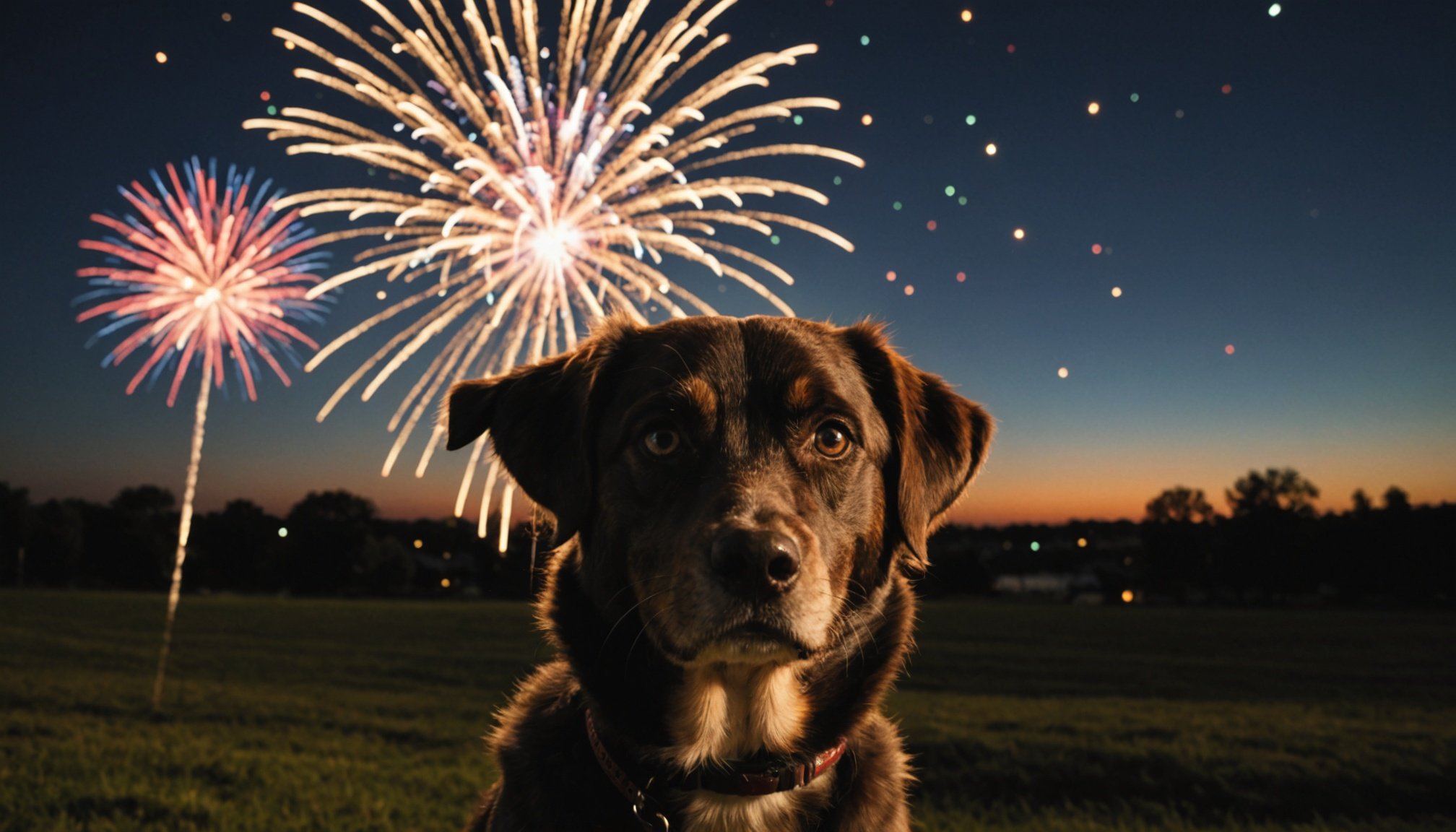Understanding Firework Anxiety in Dogs
When it comes to dog fireworks anxiety, many dog owners struggle to help their pets. Canine behavior shifts during fireworks due to an overwhelming sensory overload from loud noises and bright lights. These triggers can be deeply unsettling for dogs, resulting in anxiety. Much like us, dogs have their own anxiety triggers, and this often includes fireworks.
Symptoms of fireworks anxiety in canines can vary, with common signs including trembling, hiding, excessive barking, or even trying to escape. These behaviors can be distressing for both the dog and the owner as they indicate high discomfort levels.
In parallel : Mastering Command Training: Proven Techniques to Teach Your Dog Obedience
The impact of fireworks on dog behavior and well-being should not be underestimated. Anxiety precipitated by fireworks can negatively affect a dog’s mental and physical health. Dogs may experience increased heart rates, loss of appetite, or reduced engagement with their environments. In severe cases, anxiety can lead to long-term behavior changes, such as heightened sensitivity to other loud noises or general nervousness.
Understanding the underlying causes of this anxiety is the first step towards finding effective solutions and improving the overall well-being of dogs during the firework season. Effective management requires patience, understanding, and often a multifaceted approach.
Also to discover : Top Strategies for Successfully Welcoming a New Ferret into Your Established Group
Effective Calming Techniques for Dogs
Fireworks can be distressing, but employing calming techniques for dogs can offer significant anxiety relief. Creating a serene environment involves not only physical adjustments but also a broader understanding of your dog’s stress response.
Safe Spaces and Hiding Spots
Safe spaces are crucial to helping dogs manage fear. Whether it’s a cozy corner with their favourite blanket or a designated room, these havens can drastically reduce anxiety levels. Ensure the area is easily accessible and away from windows to minimise exposure to noise and light. Encouraging your dog to use these spaces during non-stressful times can make them more appealing during fireworks.
Music and White Noise
Playing soothing sounds can act as a stress reduction tool. Music specifically designed for dogs, such as classical or soft instrumental, or white noise machines, help to mask external noises. Introduce sound therapy gradually to avoid overwhelming your pet.
Desensitization Training
Desensitization involves gradual exposure to firework sounds, paired with positive reinforcement, to acclimate your dog over time. Consistent training builds resilience and confidence, showcasing success in many cases. Patience is essential, as every dog’s adaptation pace varies.
Recommended Products for Firework Anxiety
Anxiety Wraps and Thundershirts
For many dogs, anxiety wraps offer physical comfort through gentle pressure. This concept, similar to swaddling an infant, can soothe nervous dogs during stressful events like fireworks. Thundershirts, a popular choice, are praised for their effectiveness. Research shows they reduce anxiety symptoms in a significant number of cases by providing a sense of security and ease. Pet owners find Thundershirts particularly useful, claiming noticeable calming effects on their dogs.
Each dog is unique; thus, choosing the correct size and fit is essential for optimal effectiveness. A snug yet comfortable fit ensures the wrap functions as intended without restricting movement or causing discomfort. Familiarize your dog with the wrap gradually. Introducing it in a calm setting ensures your dog associates it with positive experiences.
Pheromone Diffusers and Sprays
Pheromone-based dog anxiety products can play a key role in soothing nervous dogs. These diffusers and sprays release synthetic versions of calming pheromones, mimicking natural comforting signals. Popular products like Adaptil have shown promising results. They’re known for easing tension and creating a more relaxed environment for dogs during noisy events.
Applying these solutions ahead of anticipated stressors, such as fireworks, maximizes their calming impact and enhances anxiety relief.
Calming Treats and Supplements
In managing dog anxiety, especially during stressful events like fireworks, calming treats and supplements can offer valuable relief. These products are specially formulated to promote relaxation without sedating your dog.
Calming treats are often infused with natural ingredients such as chamomile, lavender, or L-theanine, known for their soothing properties. Veterinarians and pet nutritionists often recommend these to help alleviate symptoms of stress. They can be particularly useful in situations where anxiety triggers, such as fireworks, are anticipated.
Natural supplements like CBD oil have also gained popularity due to their potential calming effects. Always consult with a vet before introducing new supplements, to ensure they are safe and suitable for your pet.
Several respected pet care brands offer these products. They are often praised in testimonials, with many pet owners noting reduced anxiety levels in their dogs.
By incorporating these calming aids into your pet’s routine, you can enhance their well-being, making firework celebrations less daunting for your furry friend. Always opt for treats and supplements that are reviewed and endorsed by experts, providing peace of mind for both you and your dog.
Expert Insights and Pet Owner Testimonials
To effectively manage firework anxiety in dogs, leaning on expert advice and shared experiences from pet owners can be invaluable. Veterinarian recommendations are often grounded in extensive research and practical experience. They frequently suggest a combination of environmental management, behavior modification, and sometimes pharmacological interventions to reduce anxiety.
Personal testimonials from dog owners highlight successes achieved through tailored approaches specific to each dog’s needs. Techniques that work for one dog might not be effective for another, underscoring the importance of observing and understanding your pet’s unique anxiety triggers.
Dog trainers also offer helpful insights into behavior modification strategies. They advise patience and consistency, as these are key to supporting dogs through anxiety-inducing situations. Some trainers focus on positive reinforcement and systematic desensitization, which, over time, can significantly improve canine behavior during stressful events like fireworks.
Pet owners often express relief after discovering effective solutions, emphasizing the importance of trying varied methods. Sharing these experiences helps build a community of support for those navigating similar challenges, ultimately leading to more effective and compassionate care for anxious dogs. Through this collective knowledge, owners can better tune into their pets’ needs and foster a reassuring environment.
Understanding Your Dog’s Needs
Adapting to your dog’s distinct needs is central to tackling anxiety management effectively. Observing your dog’s behavior can provide critical insights into their mental health and help develop methods suited to their temperament.
Identifying Signs of Distress
Recognizing signs of distress is pivotal in understanding canine mental health. Common physical cues include pinned ears, pacing, and excessive panting. Emotionally, dogs may appear withdrawn or exhibit obsessive behaviors. Monitoring these cues during anxiety episodes aids in addressing distress promptly.
When to Seek Professional Help
Professional guidance benefits both dogs and their owners, especially when anxiety is severe. If your dog exhibits persistent fearfulness, aggression, or prolonged distress, consulting an animal behaviorist can be invaluable. Specialists can assess specific triggers and offer personalized strategies for effective anxiety management.
Building a Supportive Environment
Creating a consistent and supportive environment promotes a sense of security in dogs, which is essential for their well-being. Regular routines, combined with positive reinforcement, enhance dogs’ comfort and confidence. Owners are encouraged to offer emotional support continually, helping understanding dog behavior and fostering a deep bond. Working towards a structured, empathetic setting can transform anxiety into adaptability over time.







